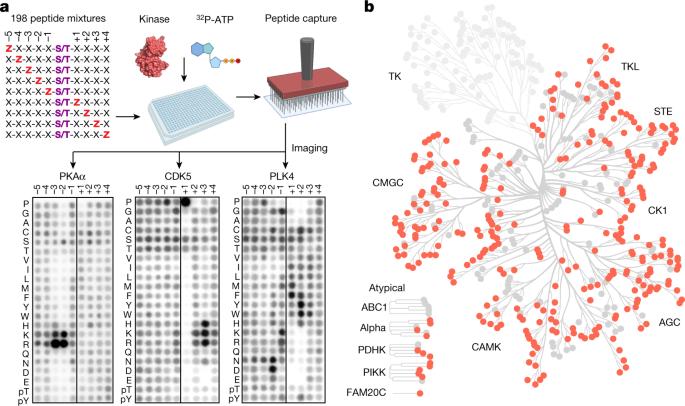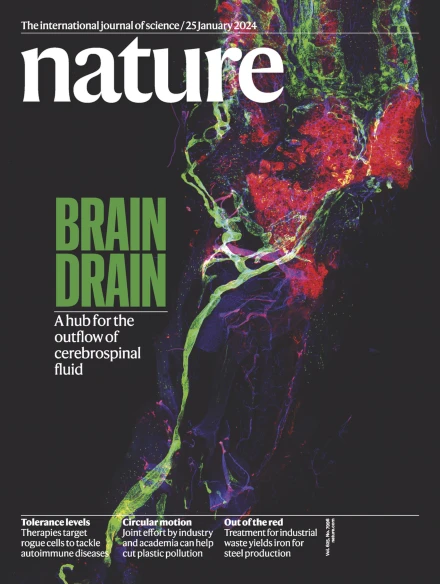人类丝氨酸/苏氨酸激酶的底物特异性图谱。
IF 50.5
1区 综合性期刊
Q1 MULTIDISCIPLINARY SCIENCES
引用次数: 65
摘要
蛋白质磷酸化是生物学中最广泛的翻译后修饰之一1,2。随着以质谱为基础的磷酸化蛋白质组学的进展,到目前为止已经确定了9万个丝氨酸和苏氨酸磷酸化位点,其中数千个位点与人类疾病和生物过程有关3,4。对于绝大多数磷酸化事件,目前尚不清楚人类基因组中编码的300多种蛋白丝氨酸/苏氨酸(Ser/Thr)激酶中的哪一种起作用。在这里,我们使用合成肽库来分析303种丝氨酸/苏氨酸激酶的底物序列特异性,这些酶/苏氨酸激酶包括超过84%预测在人类中有活性的酶。从整体上看,kinome的底物特异性比预期的要多样化得多,并且广泛地受到负选择性的驱动。我们使用我们的全激酶数据集来计算注释和鉴定能够磷酸化人类丝氨酸/苏氨酸磷酸化蛋白组中每个已报道的磷酸化位点的激酶。对于先前报道的假定的蛋白激酶所涉及的少数磷酸体,我们的预测非常一致。当这种方法被应用于研究组织和细胞系对激素、生长因子、靶向抑制剂和环境或遗传扰动的信号反应时,它揭示了对通路复杂性和补偿的意想不到的见解。总的来说,这些研究揭示了人类丝氨酸/苏氨酸激酶组内在的底物特异性,阐明了细胞信号反应,并提供了将磷酸化事件与生物学途径联系起来的资源。本文章由计算机程序翻译,如有差异,请以英文原文为准。

An atlas of substrate specificities for the human serine/threonine kinome
Protein phosphorylation is one of the most widespread post-translational modifications in biology1,2. With advances in mass-spectrometry-based phosphoproteomics, 90,000 sites of serine and threonine phosphorylation have so far been identified, and several thousand have been associated with human diseases and biological processes3,4. For the vast majority of phosphorylation events, it is not yet known which of the more than 300 protein serine/threonine (Ser/Thr) kinases encoded in the human genome are responsible3. Here we used synthetic peptide libraries to profile the substrate sequence specificity of 303 Ser/Thr kinases, comprising more than 84% of those predicted to be active in humans. Viewed in its entirety, the substrate specificity of the kinome was substantially more diverse than expected and was driven extensively by negative selectivity. We used our kinome-wide dataset to computationally annotate and identify the kinases capable of phosphorylating every reported phosphorylation site in the human Ser/Thr phosphoproteome. For the small minority of phosphosites for which the putative protein kinases involved have been previously reported, our predictions were in excellent agreement. When this approach was applied to examine the signalling response of tissues and cell lines to hormones, growth factors, targeted inhibitors and environmental or genetic perturbations, it revealed unexpected insights into pathway complexity and compensation. Overall, these studies reveal the intrinsic substrate specificity of the human Ser/Thr kinome, illuminate cellular signalling responses and provide a resource to link phosphorylation events to biological pathways. Analysis of the kinase activity of 300 protein Ser/Thr kinases reveals that the substrate specificity of the kinome is substantially more diverse than expected and is driven extensively by negative selectivity
求助全文
通过发布文献求助,成功后即可免费获取论文全文。
去求助
来源期刊

Nature
综合性期刊-综合性期刊
CiteScore
90.00
自引率
1.20%
发文量
3652
审稿时长
3 months
期刊介绍:
Nature is a prestigious international journal that publishes peer-reviewed research in various scientific and technological fields. The selection of articles is based on criteria such as originality, importance, interdisciplinary relevance, timeliness, accessibility, elegance, and surprising conclusions. In addition to showcasing significant scientific advances, Nature delivers rapid, authoritative, insightful news, and interpretation of current and upcoming trends impacting science, scientists, and the broader public. The journal serves a dual purpose: firstly, to promptly share noteworthy scientific advances and foster discussions among scientists, and secondly, to ensure the swift dissemination of scientific results globally, emphasizing their significance for knowledge, culture, and daily life.
 求助内容:
求助内容: 应助结果提醒方式:
应助结果提醒方式:


